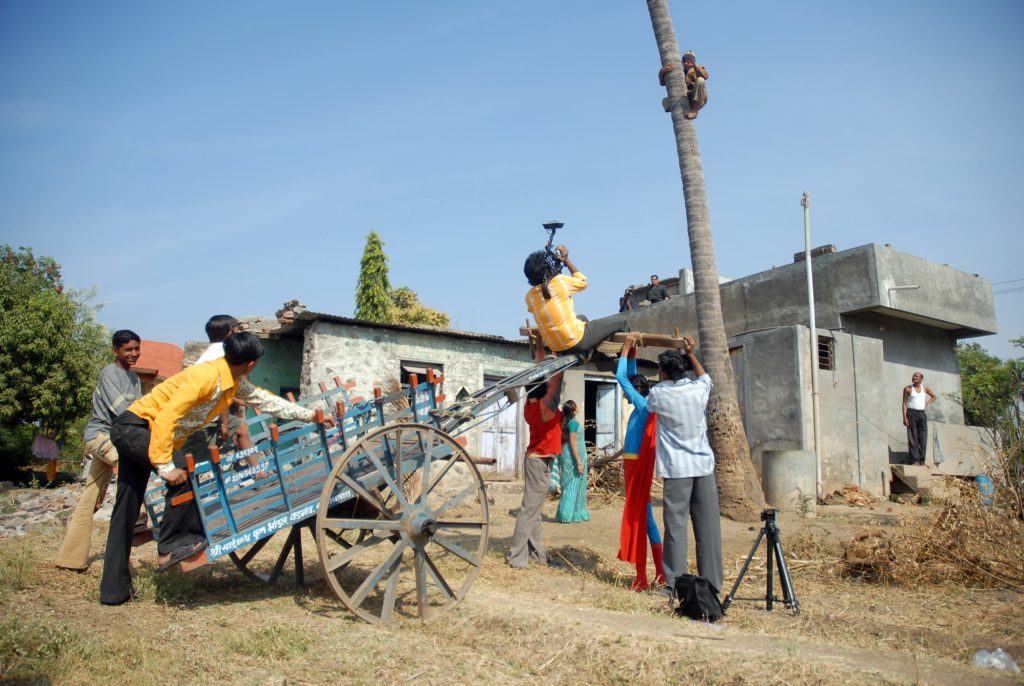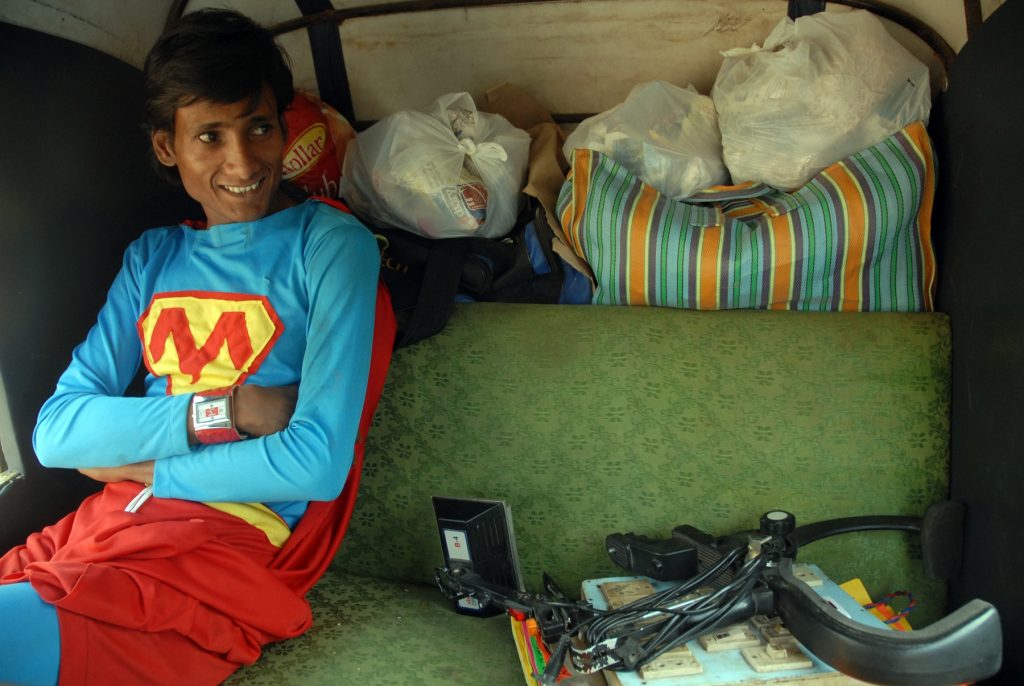This review first appeared on Totally Filmi on June 27, 2012.
“Malegaon has many identities. Among them is an obsession for films. Theatres are packed on Fridays because power-looms are closed. A worker is exhausted after a week of hard work at the looms. His mind is numb, so he watches a film on Friday, surrenders his consciousness, and imagines himself on the screen. Trades his reality for a fantasy.”
– Shakeel Bharti, resident of Malegaon
Malegaon, Maharashtra, located about 280 kilometres from Mumbai, is a place where there is, according to its residents, continuous communal tension, and where people keep to their side of the river, Hindus on one side, the Muslim majority on the other. The river may divide them, but on one thing they would both agree: both sides love films.
Movie posters line walls, kites bearing images of favorite stars are sold and flown — “Shahrukh Khan costs four rupees,” we are told, whereas Amitabh Bachchan’s Don will set you back six. And if you want to look like your favorite star, the “complete look” will cost you 101 rupees, in the case of Shahrukh Khan, or 151 for Sanjay Dutt (because of his longer hairstyle – this, of course, being Sanjay Dutt in his mullet days).
Essentially, there is no other source of entertainment in Malegaon beyond video theatres and video parlours. And not much about Malegaon has changed over the years, except perhaps that whereas a generation ago, people would worship actresses, today, instead, they worship the heroes.
Perhaps the most movie mad of all Malegaon’s residents is filmmaker Sheikh Nasir. Nasir used to run a video parlour himself, screening all kinds of films (“comedy, action, horror, Jackie Chan, Jet Li”). He’d read the newspapers to find out what was popular in Mumbai, and then he’d show it himself, creating his own movie posters as advertisement. Inspired by the films he showed and watched, he decided to make films himself. He bought a camera, started with wedding videos, made a few films, and then realised what he really should be doing is making a comedy – and thus, decided to make a parody of Sholay.
His reasoning for making a comedy? “I realised that people still love Charlie Chaplin, even though it’s 50 years old…a comedy lasts forever. It is eternal.”
And even though Nasir made Malegaon ke Sholay for the sheer fun of it, the film was a bit of a local hit, running for two months in his video parlour – tickets for the film were even sold on the black market. As Nasir points out, “Malegaon ke Sholay was a huge hit in Malegaon.”
And I think that’s the key to his films – Nasir takes a familiar story, a familiar concept, but marries it to the local dialect and the local context. That forges an instant connection with the community, and they embrace what he does with enthusiasm, many of them contributing to the process, either making costumes or doing make-up, writing scripts, and in the case of his latest venture, Malegaon ka Superman, helping Nasir struggle with his attempts at using chroma keying (aka “green screen”) to make his Superman fly.

Faiza Ahmed Khan’s documentary, Supermen of Malegaon, is a marvellous film within a film, tracing the making of Nasir’s creation of Malegaon ka Superman. Nasir is pretty much self-taught, learning his craft from the many films he has watched, taking his inspiration from them. Nasir is aware that for him, films are an obsession, and it’s an obsession he shares with the people who help him make his films, from Farogh Jafri, one of his scriptwriters who dreams of making it in Bombay, to Hamid Subhani, to Akhram Khan (who not only helps with the script, but does everything from cinematography to editing and dubbing the film, writing music for it, and also shaves his head and pops blue contacts in to transform himself into the film’s villain, a tobacco king who wants to ruin Malegaon. As well as working with Nasir, he also makes his own films.)
Nasir’s Superman is the unlikeliest of superheros though. Portrayed by the almost unbearably scrawny Shafique (who, sadly, died of cancer shortly after a public screening of the film last fall), this Superman is asthmatic because of all the pollution. He gets dizzy when he flies in circles. The string of his underwear (worn on the outside, of course) hangs out — “for comedy”, says Nasir. When Superman’s father sends him off on a mission, he launches him on the river in a giant inner tube. Shafique, himself, seems so shy and unsure, yet is thrilled to have been offered such a big role, so much so that he takes a leave from that much needed job at the looms to be available and on time to work on the film. It’s almost heartbreaking to hear him speak of his dream, to step into one of Amitabh Bachchan’s roles, a dream sparked, surely, by his love for the Big B and his desire to be like him after seeing his films as a kid.

Khan gives us a truly touching portrait of everything and everyone involved in making this film. She shows us the difficulties of a community like Malegaon – poor, divided. But her film also reflects the great spirit of the place, and is always respectful of everyone involved. She may wonder why the women of Malegaon do not act in Nasir’s films (the heroine, Trupti, is an import, from Dhulia, because Malegaon’s Muslim community is too conservative to permit its women to participate – “I’ve noticed women here don’t live frankly,” comments Trupti. And in fact, it’s only men who go to watch films, too), but Khan is careful not to judge what she is filming. In fact, the judgement, if there is one, comes from the residents of Malegaon themselves. Poverty, we are told, means fewer people can go to school, and lack of education means a community where new ideas and ways of thinking cannot develop.
If Nasir and his fellow filmmakers are obsessed about making films, they are also firmly rooted in practical realities as well. Nasir sells advertising space in his film – in the case of Malegaon ka Superman, Superman drinks milk to increase his ability to fly, advertising for a local milk shop – even the son of the owner gets a small role in Nasir’s film.
And if he borrows money from his brother Nadeem to make his films, he also discourages his brother from seeing filmmaking as anything more than a hobby. “There’s no future in it,” he says, worrying that if his brother gets too involved in making films, he’ll forget about “real work”, about making sure that he takes care of his future.
It would be altogether too easy to see Malegaon’s filmmakers as a bunch of madmen with big dreams and no budgets. But in Khan’s hands, we see them for what they truly are: mad, surely, but in the finest sense of that word, living out their passions and, for the most part, making their dreams reality. It’s a passion that connects immediately with the viewer, endearing them to us – and to others, too, for maverick filmmaker Anurag Kashyap (a Totally Filmi Casa Favorite) is also a fan of the filmmakers of Malegaon, so much so that he helped arrange for a public screening of Malegaon ka Superman in the fall of 2011. If I have one wish, it’s that Kashyap would help make the films available to those of us who really would love to see them.
Nasir’s film truly is a labour of love for everyone involved – they must find the time to make the film as they work around their jobs – a necessity, of course, because you can’t make films unless you have a job that provides you with the food to fuel you to make films. But it’s also evidence of the great creativity that exists in Malegaon – not for nothing were its filmmakers included in Open magazine’s list of 50 most creative Indians. These guys imagine what they want, and then, by hook or by crook, they make it happen. The documentary shows us only a few clips from Nasir’s final product, but the results are impressive – the film is funny, creative, and there’s evidence of great ingenuity at work. Most importantly, the filmmakers of Malegaon are proof that if you want to, even with practically no budget, and pulling together a group of dreamers, you can, indeed, make Superman fly. Even in a place as unlikely as Malegaon.
Supermen of Malegaon has screened at 36 festivals and won 15 awards. It’s also been crafted by some amazingly talented people, names on the rise in mainstream Indian cinema, such as Sneha Khanwalkar and Hitesh Sonik, who wrote the score (and who have worked on films such as Oye Lucky, Lucky Oye, Kaminey, Omakara and Gangs of Wasseypur), Sweta Venkat, who edited the film (known for That Girl in Yellow Boots and Gangs of Wasseypur); Gargey Trivedi, (My Friend Pinto)the film’s co-producer and cinematographer; and sound designer Niraj Gera (Valu).
The film has managed to secure a theatrical release in India on June 29th, no mean feat when we all know that it’s really a challenge for alternative, arthouse, regional or documentary films to find a place amongst all the commercial films.
Supermen of Malegaon will play in Mumbai at PVR Cinemas as part of their most excellent Director’s Rare initiative, designed to support critically acclaimed and independent films in gaining a theatrical release. I would highly recommend this most excellent documentary to everyone – I would give my eye teeth to be in a cinema this Friday to support this film, and I sincerely hope if you have the chance, you will, too.

